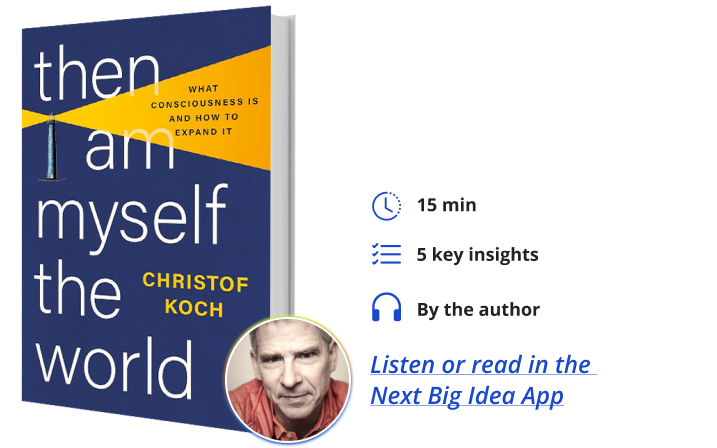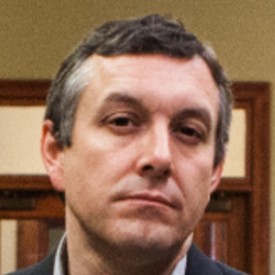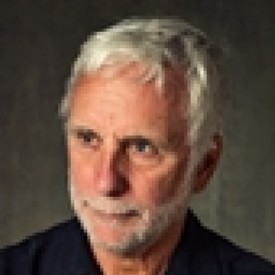Christof Koch is a neurophysiologist and computational neuroscientist. He was President and Chief Scientist of the Allen Institute for Brain Science and remains at the Institute as a Meritorious Investigator. He is also Chief Scientist of Tiny Blue Dot Foundation, which supports research into neuroscience-based therapies.
Early in his career, he was a faculty member at the California Institute of Technology, leading a laboratory there for more than a quarter century while teaching and mentoring more than one hundred graduate and post-graduate students. His laboratory published over 350 peer-reviewed papers, countless book chapters, and patents. Christof worked closely with Francis Crick, the famed co-discoverer of the shape of the DNA molecule.
Below, Christof shares five key insights from his new book, Then I Am Myself the World: What Consciousness Is and How to Expand It. Listen to the audio version—read by Christof himself—in the Next Big Idea App.

1. My near-death experience.
I’m an uncommon example of someone who has undergone a near-death experience and is also a neuroscientist obsessed with identifying the substrate of this, or any other, conscious experience. When it happened to me, within seconds, my entire field of view became engulfed by dark, swirling smoke. The space around me fractured into a thousand hexagons and shattered. The speed with which this happened left no time to regret the situation I had gotten myself into. As I was sucked into a black hole, my last thought was that with the dying of the light, I too would die. And I did.
I ceased to exist in any recognizable way, shape, or form. No more Christof, no more ego, no more self; no memories, dreams, desires, hopes, fears—everything personal was stripped away. Nothing was left but a non-self: this remaining essence wasn’t man, woman, child, animal, spirit, or anything else; it didn’t want anything, expect anything, think anything, remember anything, dread anything. But it experienced.
It saw a point of cold white light of unbearable intensity, unable even to conceive of looking away, as there was no “away from.” There was no left or right, up or down, front or back, far away or close by. There wasn’t a black canvas upon which the light existed, as there was no space. There were no other attributes: no color, no motion, no texture, no sound or silence, no smell, no body, no pleasure, no pain. What there was was a timeless universe convulsed to a blazing, icy light. That and a profound feeling of both terror and ecstasy, the awfulness of pure experience lasting indefinitely—for there was no perception of time. The experience wasn’t brief or long. It simply was.
Besides taking away my fear of death, my experience vividly demonstrated that when the chips are down, what remains is pure experience. There was no external world, no body nor a self; nothing but a space collapsed into a singularity of overwhelming brightness and an extraordinary mixture of terror and ecstasy.
2. The quest for understanding consciousness.
I’ve tracked the neuronal footprints of consciousness my entire adult life. I started this search back in the late 80s when I met a kindred spirit: the British molecular biologist Francis Crick, who co-discovered the helical structure of the DNA molecule and helped decipher the genetic code. We wrote two books and many articles together, advocating for identifying the molecules and circuits in the brain sufficient for any one specific conscious percept and outlining a pragmatic strategy for this quest.
“The community of scientists who study such matters still disagree on which bits and pieces of brain tissue mediate any one conscious experience.”
It’s taking a long time, though! Last year, I lost a 25-year wager, made in 1988 against the philosopher David Chalmers, when I had to publicly admit that the community of scientists who study such matters still disagree on which bits and pieces of brain tissue mediate any one conscious experience. But sooner or later, we will know the answer.
3. Shift in philosophical paradigm.
My near-death experience forced me to reconcile my stance as a scientist with my inner child, sitting around the campfire, entranced by the stories of other people’s mystical and transformative experiences.
Back in the 80s and 90s, the dominant position in Anglo-Saxon philosophy departments was a single-minded metaphysical belief in the righteousness of physicalism and materialism for the 20th century. Physicalism (the belief that all that is real can be described by our physical theories) had seemingly defeated its millennial-old enemy, dualism (the belief in a mental domain of existence independent of the material, sometimes identified with the soul. The supremacy of physicalism was voiced by the doyen of American philosophy Daniel Dennett, who crowed, “Dualism is not a serious view to contend with, but rather a cliff over which to push one’s opponents.” This triumphalism, however, turned out to be premature, and classical physicalism itself is in decline.
However, like any centuries-old dogma, physicalism has momentum and powerful institutions behind it. So, to most, the death throes of physicalism as an all-encompassing metaphysical system of belief comes as news.
4. The shortcomings of physicalism and the emergence of integrated information theory.
The practice of science is extraordinarily successful in characterizing the universe, from its smallest constituents (quarks) to its largest (superclusters of galaxies). Technology, the daughter of science, benefits society in the form of COVID-19 vaccines, solar cells, large language models, or quantum computing. But physicalism fails to explain the metaphysical underpinning of science. Physicalism does not provide a satisfactory explanation of matter; the more we smash elementary particles into each other, the better we can predict, yet the less we understand what is meant by “the physical”—as the mind-bending paradoxes of quantum mechanics attest to.
“Consciousness refuses to be canceled.”
Physicalism has likewise been unable to satisfactorily account for experience. Explanations for how the brain (a piece of furniture of the universe, like any other) can feel something come up short, again and again. Denying the existence of consciousness, denigrating its causal efficiency, gaslighting us into believing that our feelings about the painfulness of pain or the beauty of a sunset are an illusion have come to naught. Consciousness refuses to be canceled. The challenge is to explain the subjective aspects of experience with the objective tools of science. Fortunately, now, we have a formal theory called the integrated information theory (IIT) of consciousness, which does exactly this.
5. Liberating ourselves with integrated information theory.
IIT has emerged as the most prominent scientific theory of consciousness over the past two decades. The theory advocates that consciousness is ultimately the capacity of complex systems to exert causal powers upon themselves—to be agents of change.
Physicalism starts with the material world (the brain) and then seeks to squeeze the juice of consciousness out of it. This is hard with a capital H, as Dave Chalmers has emphasized, and has not worked.
Instead, we must return to earlier schools of thought that give primacy to the mental and ask what properties in the world are necessary to support it. This is the approach of the integrated information theory. It predicts the bits and pieces of the cortex that are the substrate of experience. This happens somewhere in the back of the cortex, the outmost layer of the brain (experience doesn’t require the frontal cortex, which is associated with reasoning, language, and decision-making). IIT lets us measure not just our own level of consciousness, that is, the quantity of consciousness (or the system’s integrated information), but also its qualitative aspects, such as why red feels the way it does or the emotions from a high C, or that of a toothache.
IIT leads to clinically relevant devices to detect the presence of consciousness in severely injured and behaviorally unresponsive patients. IIT explains mystical and psychedelic experiences that abolish egoic consciousness and reveal the extent to which we inhabit a constructed reality, a narrative of our own making. Finally, IIT takes a firm stance on digital computers as presently engineered: they will never be conscious, although they will eventually become super-intelligent.
Consciousness is ultimately about being, not about doing. We are liberating ourselves from the constraints of strait-laced physicalism with an empirically testable theory that centers on experience, meaning the only thing that exists for itself, in an absolute sense. A theory that explains how the mind and its causal powers create the world, including the most active piece of organized matter in the known universe: the brain.
To listen to the audio version read by author Christof Koch, download the Next Big Idea App today:































